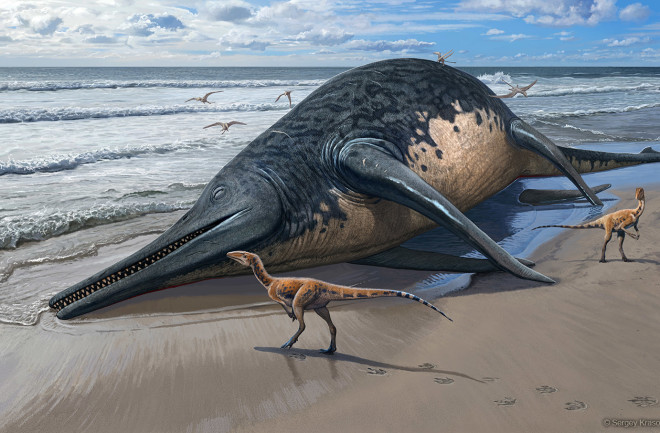A father and daughter, searching for fossils on an English beach, found more than they expected: the jawbone of what may be the largest known marine reptile. Scientists estimate that the giant ichthyosaur, from which the jawbone came, measured 80 feet long and lived during the late Triassic period. A report in the journal PLOS details the find.
When Justin Reynolds and Ruby Reynolds (then 11) were combing the beach at Somerset in 2020 and came upon a giant bone chunk, they knew they were on to something.
“When Ruby and I found the first two pieces we were very excited as we realized that this was something important and unusual,” said Reynolds in a release. So they contacted Dean Lomax, a University of Manchester paleontologist.
Lomax confirmed their hunch that the bone was, indeed, from an ichthyosaur. "These jawbones provide tantalising evidence that perhaps one day a complete skull or skeleton of one of these giants might be found. You never know," said Lomax in a press release.
Ichthyosaur Peaked in the Late Triassic
Ichthyosaurs first showed up during the early Triassic period around 250 million years ago. Over a few million years, they grew to as large as 49 feet. The reptile peaked in size about 200 million years ago during the Late Triassic.
"It is quite remarkable to think that gigantic, blue whale-sized ichthyosaurs were swimming in the oceans around what was the UK during the Triassic Period," said Lomax in the release.
The 2020 find closely resembles one unearthed a few miles away in 2016, farther along the coast at Lilstock by fossil hunter Paul de la Salle. Lomax, la Salle, and others described that fossil in 2018. Besides being larger than the earlier find — at over six feet long — the more recently found jawbone has some other notable features.
“This new specimen is more complete, better preserved, and shows that we now have two of these giant bones (called a surangular) that have a unique shape and structure,” said Lomax.
Lomax was impressed that Ruby and Justin suspected that their discovery was an ichthyosaur jawbone. “They recognized that it matched the one we described in 2018,” he said. “I asked them whether they would like to join my team to study and describe this fossil, including naming it.”
Read More: Why Were Prehistoric Marine Reptiles So Huge?
Multimillion-Year-Old Jigsaw
Justin and Ruby, together with la Salle, Lomax, and several family members, returned to the site to hunt for more pieces, then fit them together like a multimillion-year-old jigsaw. The last piece was found October 2022. They named the new genus and species Ichthyotitan severnensis, meaning “giant fish lizard of the Severn.”
When asked about her involvement with the study, Ruby said in a statement, “It was so cool to discover part of this gigantic ichthyosaur. I am very proud to have played a part in a scientific discovery like this.”
Father and daughter appear as authors on the paper. The jawbone will be displayed at the Bristol Museum and Art Gallery.
Read More: 5 of the Most Interesting Prehistoric Marine Reptiles
Article Sources
Our writers at Discovermagazine.com use peer-reviewed studies and high-quality sources for our articles, and our editors review for scientific accuracy and editorial standards. Review the sources used below for this article:
PLoS ONE. The last giants: New evidence for giant Late Triassic (Rhaetian) ichthyosaurs from the UK.
Dean Lomax. University of Manchester paleontologist
The University of Manchester. UK giant ichthyosaur is one of the largest animals ever.
Before joining Discover Magazine, Paul Smaglik spent over 20 years as a science journalist, specializing in U.S. life science policy and global scientific career issues. He began his career in newspapers, but switched to scientific magazines. His work has appeared in publications including Science News, Science, Nature, and Scientific American.

